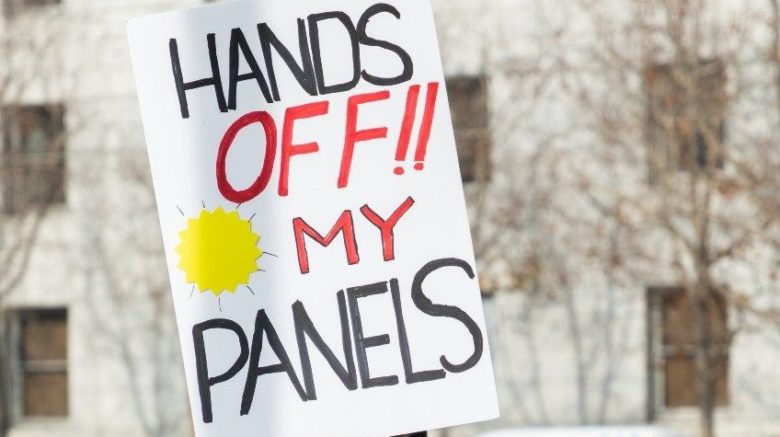Summary
Rooftop solar and battery storage helps reduce the cost of the electrical grid, saving all ratepayers money
The continued growth of rooftop solar and battery storage is key to a successful clean energy transition that puts the needs of the public at the center, with lower costs, protection from blackouts and quicker pollution reductions than if we simply double down on more long-distance energy.
The most detailed modeling available shows that integrating lots of local solar and storage with large-scale renewables as part of the clean energy transition could save Californians $120 billion over the next thirty years. These savings occur because local distributed energy reduces the price tag of long-distance power lines and peak demand infrastructure. It does not eliminate it altogether. But it reduces their risk and expense, with major economic benefits flowing to individuals and the community.
Details and sources for each are in the full White Paper
California utilities have a different story: they claim that rooftop solar is bad for California
Utilities claim that solar users impose an annual cost of $3 billion on other ratepayers. They say this “cost shift,” as they call it, happens because solar users don’t pay their fair share for the electrical grid, that the credit solar users receive for the energy they share back to the grid is overvalued.
The utility claim is unsupported by the evidence, and as this paper shows, is created by using three questionable accounting fallacies.
How the utilities justify their claim: Three accounting fallacies
The utilities base their claims on studies they perform regarding the value of rooftop solar energy. They create computer models that purport to account for the value to ratepayers of each kilowatt-hour of solar energy generated by on-site solar, both in the past, present, and future.
The utilities make their claim of a solar “cost-shift” by manipulating the computer modeling, specifically through three accounting fallacies, outlined below. When these accounting fallacies are corrected, the cost shift claim falls flat.
- Accounting fallacy #1: Counting solar energy made and used on-site (instead of buying it from the utility) as a “cost” to other ratepayers. This is similar to arguing that households with vegetable gardens are forcing households without gardens to pay more for food. It also flips a standard principle of ecology on its head, suggesting that reducing one’s burden on society’s infrastructure is negative and should be penalized. It would be one thing if the real-world evidence supported this point of view. But it doesn’t.
- Accounting fallacy #2: Omitting over a decade of rooftop solar benefits. Typical energy planning calculates the benefits of an “energy asset” to all ratepayers over the asset’s entire lifetime. An energy asset is a power plant, a wind turbine, or in this case, a rooftop solar system. Rooftop solar systems usually warranted for 20-25 years and can actually last a lot longer. But the utilities only calculate a single year of rooftop solar’s benefits, and then represent those single years of benefits only over a short ten year period (2020-2030).
- Accounting fallacy #3: Lowballing the long-distance power line costs that rooftop solar helped avoid. The CPUC’s previously mentioned computer model is supposed to include assumptions about how rooftop solar reduces spending on long-distance power lines. But the computer model’s assumptions shortchange these savings, helping the utilities further lowball the true value of rooftop solar and battery storage in their calculations.
Details and sources for each are in the full White Paper
The real cost shift: Rate hikes, blackouts and wildfires
These irregular accounting methods help the utilities deflect attention from the root cause of California’s ever-rising electricity bills – the escalating costs of long-distance power lines. California’s utilities are incentivized by the government to maximize spending on this infrastructure, reaping a guaranteed 7-10% profit margin for every ratepayer dollar spent. This perverse incentive, coupled with lax regulatory oversight, has led to a massive spending spree by utilities — all shouldered by ratepayers.
California utilities and their allies are now pushing to make their failed system the exclusive path forward in California’s high-stakes effort to switch to 100% renewable energy and fully decarbonize the economy.
Doubling down on this centralized system and excluding consumer choice and prosumer solutions like rooftop solar is a recipe for failure. This is not a zero sum game. California needs all clean energy and decarbonization strategies on the table. And, as noted earlier, the data points to a much better way.
Details and sources for each are in the full White Paper
The utility echo chamber
The utilities’ “cost shift” claim is promoted by a small group of seemingly independent utility allies in coordination with the major investor-owned utilities. These include organizations who should know better, but for one reason or another have chosen to align with the utilities: the Haas School of Business at Berkeley, Natural Resources Defense Council (NRDC), The Utility Reform Network (TURN), Public Advocate’s Office at the California Public Utilities Commission (CPUC), AARP and utility-favored consulting firms like Energy & Environmental Economics (E3) and Verdant Associates.
Each of the organizations listed above use the same accounting methods outlined earlier to justify their position, in many cases referring to each other in a circular pattern, and in one instance, simply using the utilities’ raw calculations.
Details and sources for each are in the full White Paper
Conclusion: Rooftop solar saves all ratepayers money and should be expanded, not blocked. The real “cost-shift” is our continued reliance on PG&E and the other profit-driven utilities.
Every rooftop solar system built today reduces the cost of the electrical grid by reducing the required number of long-distance power lines, reducing the needed infrastructure at the local distribution level, and reducing the needed capacity of utility scale generation facilities. Rooftop solar has already helped California save billions of dollars in grid infrastructure costs. If state officials allow rooftop solar to continue growing, along with battery storage, rooftop solar will save Californians $120 billion over the next thirty years.
The public, and the environmental and social justice community, are overwhelmingly in support of continuing to grow rooftop solar and battery storage, and have rejected the claims made by utilities and their echo chamber.
Given the irregular accounting fallacies identified in this paper, we urge members of the news media, policymakers and the public to closely examine the cost shift claims to understand their false and illogical underpinnings. The cost shift claims should be rejected rather than given any further credibility.

